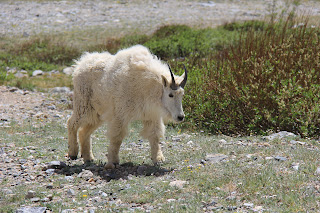It could be argued that oat bran is more highly processed, less "whole", than rolled or steel-cut oats, but I'm not going to let that dissuade me from eating it.
So far, my favorite way to prepare oat bran is with cocoa, almonds, and coconut. It has a taste and texture that falls somewhere between candy bar and cake batter. But of course, it's much better for you than either of those things.
- 1/4 cup (a little bit heaping) oat bran. You can get this in bulk at Sunflower (cum Sprouts, anon) or other health food stores.
- 3/4 cup water. It's best to use imported distilled artesian well water. Just kidding. Use the tap.
- ~ 1/4 teaspoon salt (about 4 or 5 good shakes)
- 2 tablespoons cocoa powder
- 1 oz. raw almonds (about 24 pc.), coarsely chopped. Also available in bulk.
- 1/4 cup finely shredded coconut. I use some kind of organic, unsweetened, reduced fat stuff, so, you know, I'm sure it's really good for you.
- 1 tablespoon blackstrap molasses.
- 1-2 teaspoons Truvia or other sweetener, to taste.
- ~ 1/4 cup almond milk
Put the first three ingredients into a fairly large soup/cereal bowl. Cook in a microwave on high for 3 to 3.5 minutes. The oat bran and water are actually measured since it only takes one measuring cup, and if you do the oats before the water, the measuring cup is clean when you're done. Also, if you get the ratio wrong the result will either be too pasty or too runny. As always, everything else is usually just kind of eyeballed, though I did measure that stuff out too one time, just to make sure my estimates are close to accurate.
Mix in the remaining ingredients except for the almond milk. Once everything else is well combined, add just enough almond milk to smooth out the texture. This also has the effect of cooling everything off so that you don't burn your mouth trying to eat the piping-hot oats. Because obviously waiting around for it to cool on its own is out of the question.
You may have noticed that this recipe follows much the same pattern as my fudge brownie oatmeal. That's not surprising or coincidental. I love the flavor combination of blackstrap and cocoa. And I don't like doing anything complicated like turning on a stove when I first wake up in the morning, so if a hot breakfast isn't coming from the slow-cooker, it has to come from the microwave. That's unpopular in gourmet circles, but I'm much more the pragmatic type.
I hope you enjoy, if you give this a try, and that it will fuel some kind of awesome adventure. Or at the very least, give you a nice happy feeling before going about your daily grind.

























